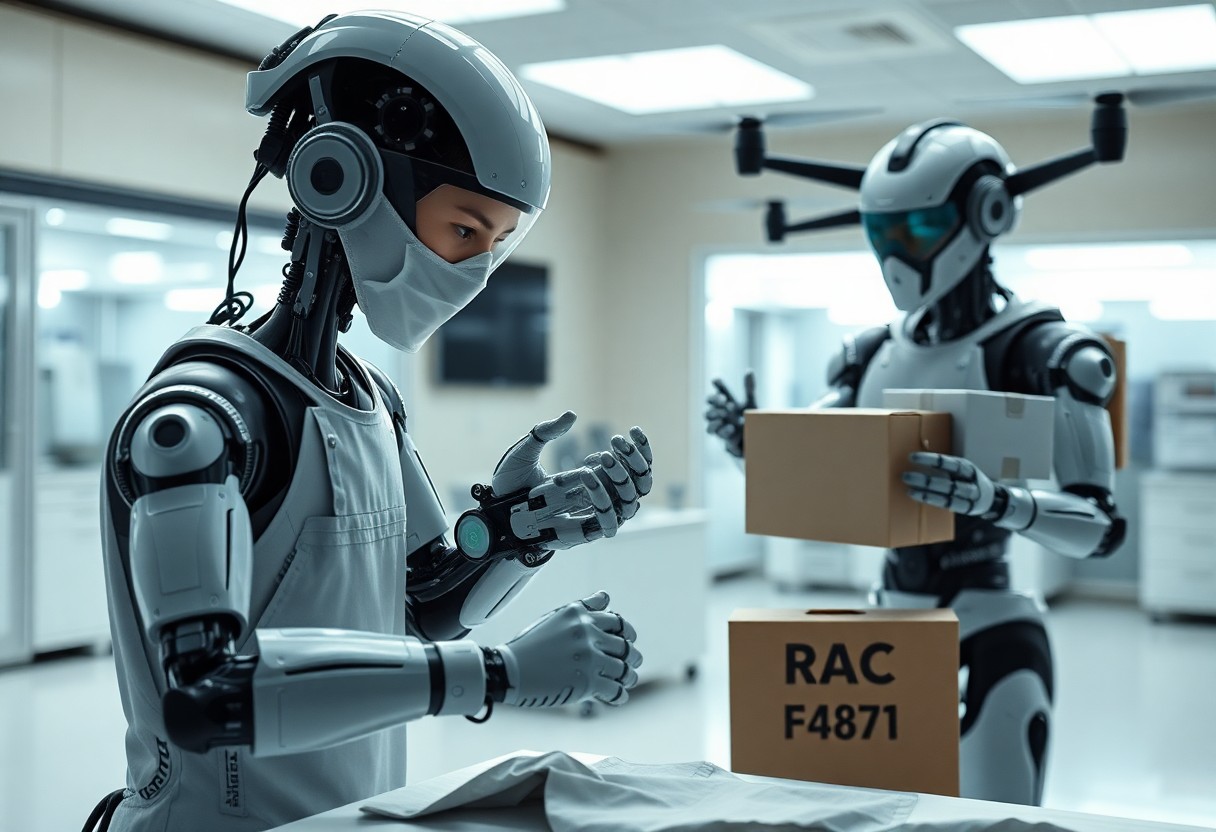Many military strategists and defense analysts are exploring the revolutionary potential of swarm robotics in asymmetric conflicts. As you research into this topic, you’ll discover how the collective capabilities of autonomous drones and robots can adapt and respond dynamically to complex battlefield scenarios. These technologies offer a unique edge, fundamentally altering the traditional power balance between state and non-state actors. Understanding these advantages enables you to envision a future where swarm robotics redefine modern warfare and strategic operations.
Understanding Asymmetric Conflicts
The complexities of asymmetric conflicts arise when opposing forces differ significantly in military power and strategy. These situations often place smaller, less-equipped groups against more formidable adversaries, creating unique dynamics and challenges that influence warfare tactics. By understanding these distinctions, you can better appreciate how innovative technologies, such as swarm robotics, might provide strategic advantages in these scenarios.
Defining Asymmetric Warfare
Across the globe, asymmetric warfare characterizes conflicts where opposing sides possess unequal military capabilities and strategies. This often includes guerilla tactics, insurgencies, and irregular warfare, where weaker forces leverage their agility and knowledge of local terrain to counteract conventional military strengths. By recognizing this fundamentally distinct form of warfare, you can understand the significant implications for defense and military planning.
Challenges Faced in Asymmetric Environments
Asymmetric conflicts pose numerous challenges, including unpredictability, resource limitations, and the difficulty of countering non-traditional tactics. These environments require flexible strategies that can adapt to rapidly changing conditions, as conventional military practices may not yield effective results. Thus, you should consider innovative solutions that address these unique obstacles.
Understanding the challenges faced in asymmetric environments is necessary for formulating effective strategies. You must navigate issues such as the lack of structured command and decentralized operations within such conflicts. The unpredictability of non-state actors and the societal dimensions involved create additional layers of complexity. This requires you to develop adaptive responses that can leverage technological advancements in areas such as intelligence gathering and combat management, positioning you to gain the upper hand in these challenging scenarios.
Overview of Swarm Robotics
Clearly, swarm robotics involves the coordination of multiple robotic units to work collaboratively to achieve complex tasks. These systems mimic social behaviors observed in nature, such as ant colonies or bird flocks, allowing for flexible and adaptive problem-solving capabilities. By leveraging such collective behaviors, swarm robotics can optimize operations in various sectors, including military, environmental monitoring, and disaster response, offering significant potential for enhancing efficiency and effectiveness.
Characteristics of Swarm Robotics
Along with their ability to perform tasks autonomously, swarm robotic systems exhibit robustness and scalability. These systems can adapt to changing environments and dynamic challenges, making them resilient in unpredictable situations. Furthermore, individual units often operate with limited information yet collectively achieve complex objectives, showcasing decentralized decision-making that enhances not only operational efficiency but also reliability in the field.
Current Applications in Military Contexts
Overview of military applications reveals the transformative potential of swarm robotics in warfare and defense scenarios. These systems can conduct reconnaissance, surveillance, and even engage in offensive actions while minimizing human risk. By deploying large groups of robotic units, military forces can create a formidable presence while maintaining flexibility in strategy and tactical execution.
For instance, several military organizations are experimenting with swarms of drones to gather intelligence and perform reconnaissance missions. Such implementations not only allow for comprehensive area coverage but also provide real-time data analysis, enhancing situational awareness for decision-makers. Additionally, swarm robotics can facilitate logistics, such as supply transport or equipment distribution in contested environments, showcasing their multifaceted applications in modern asymmetrical warfare.
Advantages of Swarm Robotics in Asymmetric Warfare
It is evident that swarm robotics offers unique benefits in asymmetric conflicts, including superior coordination, scalability, and cost-effectiveness. By leveraging the collective capabilities of multiple robots, you can dramatically enhance operational effectiveness compared to traditional systems. These advantages are explored further in the UNIDIR Swarm Robotics – 2020.pdf, where you will discover insights on how swarm robotics can reshape the battlefield dynamics in your favor.
Enhanced Flexibility and Adaptability
Against rapidly changing scenarios in asymmetric warfare, swarm robotics allows you to adapt quickly to new threats and opportunities. This means that as conditions evolve, your robotic units can reconfigure their strategies and formations, effectively responding to the unpredictable nature of asymmetric engagements.
Improved Situational Awareness and Intelligence Gathering
Swarm technology can significantly bolster your capacity for situational awareness and intelligence gathering. By deploying numerous small, interconnected drones or robots, you can create a comprehensive network that collects data from multiple angles and sources.
Robotics in swarm settings allows for real-time data analysis and information-sharing among units, enhancing your understanding of the environment. This interconnectedness not only provides you with valuable intelligence to inform your decisions but also helps identify emerging threats before they escalate. Consequently, swarm robotics enhances your operational edge by ensuring you maintain a clear picture of the battlefield, allowing for informed strategizing and swift actions.
Strategic Implications of Swarm Robotics
Unlike traditional military strategies that focus on singular units, swarm robotics can shift the balance of power in asymmetric conflicts. By leveraging the numbers and adaptability of numerous drones or autonomous vehicles, you can achieve strategic advantages that overwhelm conventional forces. This enhances battlefield awareness, logistics efficiency, and the ability to perform complex missions with decentralized control, ultimately redefining tactical norms in modern warfare.
Deterrence and Proactive Measures
One of the most significant aspects of swarm robotics is its potential for deterrence. By showcasing powerful swarm capabilities, you can deter adversaries from engaging in hostile actions, thus maintaining stability and peace. These technologies can serve as a proactive measure, dissuading attacks before they occur, effectively altering the cost-benefit analysis for your opponents.
Psychological Impact on Adversaries
On the battlefield, the psychological dynamics play a key role. Swarm robotics can instill fear and uncertainty in adversaries through their unpredictable and overwhelming nature, adding a layer of psychological warfare that challenges conventional understandings of power.
Further, the implications of this psychological impact are profound. When your enemies face a swarm of robotic units, they may feel not only outmatched but also vulnerable to an unseen, adaptable threat that could exploit any weaknesses. This uncertainty can lead to decision paralysis, making adversaries overly cautious or reactive. Such psychological stress can be more effective than physical encounters, as it can diminish morale and impede strategic planning long before an engagement occurs.
Ethical Considerations in the Deployment of Swarm Robotics
All advancements in swarm robotics introduce complex ethical dilemmas that require careful consideration. As these technologies become integrated into military strategies, they challenge traditional notions of accountability, control, and humane conduct in warfare. You must explore these ethical implications to ensure that the benefits of swarm robotics do not come at an unacceptable moral cost.
Accountability and Control Issues
The deployment of swarm robotics raises significant questions about who is responsible for the actions taken by autonomous systems. As you engage with this technology, it becomes necessary to establish clear lines of accountability, determining whether responsibility lies with operators, programmers, or the machines themselves. This ambiguity can complicate legal and ethical frameworks in asymmetric conflicts.
Potential for Collateral Damage and Civilian Impact
The integration of swarm robotics in asymmetric warfare poses risks of unintended consequences, particularly regarding civilian populations. The potential for collateral damage is a pressing concern, as autonomous systems may struggle to distinguish between combatants and non-combatants in complex environments. You must consider how to implement robust safeguards to mitigate the risks of wrongful harm to innocent lives.
Robotics designed for military applications can potentially exacerbate collateral damage due to their autonomous decision-making processes. You should be aware that these systems might not always be able to differentiate between legitimate military targets and civilians, especially in densely populated areas. As such, there is a pressing need for rigorous ethical guidelines and oversight mechanisms to minimize the risk of civilian casualties, ensuring that your use of these technologies prioritizes the preservation of human life and adherence to international humanitarian laws.
Future Prospects and Innovations in Swarm Robotics
To explore the future of swarm robotics is to envision a landscape where autonomous systems communicate and collaborate seamlessly. As this technology advances, you may witness its applications expanding across various domains, particularly in military operations where adaptability and efficiency are paramount. The potential for swarm robotics to transform strategic paradigms in asymmetric conflicts is promising, allowing for more dynamic responses to threats and challenges in unpredictable environments.
Technological Advancements
Advancements in artificial intelligence and machine learning are driving the evolution of swarm robotics. You can expect improved algorithms that enable better decision-making and coordination among autonomous units. Advances in communication technologies will enhance swarm performance, allowing for real-time data sharing and a more robust collective response to emerging tactical situations.
Integration with Existing Military Systems
Across military branches, there is a growing recognition of the need to incorporate swarm robotics into current operational frameworks. You will find that this integration allows for enhanced situational awareness and increased operational capabilities, leveraging existing technology while minimizing disruption to established systems.
And as you consider the integration of swarm robotics with current military systems, it’s imperative to recognize the value of interoperability. By ensuring that swarm units can communicate effectively with existing military assets, you can enhance command and control capabilities. This synergy paves the way for innovative operational strategies, enabling your forces to deploy swarm technologies alongside traditional systems for a more comprehensive approach to asymmetric conflicts.
Final Words
With this in mind, you can see how swarm robotics may offer significant advantages in asymmetric conflicts. By leveraging decentralized decision-making and collaborative capabilities, these systems can enhance operational effectiveness, improve resilience, and adapt swiftly to evolving environments. As you consider the implications of swarm technologies, it’s clear that they could redefine strategies in warfare and various industries, providing a new dimension to problem-solving and resource allocation.






